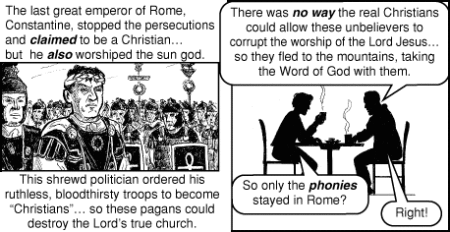Protestant View #2: The (Invisible) Remnant Theory
(2) runs into almost the exact same problems as (1). Because the problems with Protestant View #1 are so severe, and because even the verses cited for the notion of an end-times apostasy (like Matthew 24:10-14) suggest a general falling-away from the Faith, rather than a global abandonment [the verse I mentioned before even refers to some perservering to the end], Protestant View #2 devised a “remnant” soluion. This is the view that the Waldensians developed. Here’s the Jack Chick version, in a single comic panel:
 In short, it’s that only a remnant of the faithful remained after the Great Apostasy, as in certain previous times in Israel’s history. On face, there’s absolutely nothing wrong with a remnant theory. It’s quite possible that Christianity will become a religion practiced by very few, and that many of these people will have to be in hiding (at least periodically): we’ve already seen Christianity in that position in Her earliest days. It’s even possible that a great many, even a majority, of the Church’s leaders will be heretics themselves: we’ve already seen that, in the days of St. Athanasius.
In short, it’s that only a remnant of the faithful remained after the Great Apostasy, as in certain previous times in Israel’s history. On face, there’s absolutely nothing wrong with a remnant theory. It’s quite possible that Christianity will become a religion practiced by very few, and that many of these people will have to be in hiding (at least periodically): we’ve already seen Christianity in that position in Her earliest days. It’s even possible that a great many, even a majority, of the Church’s leaders will be heretics themselves: we’ve already seen that, in the days of St. Athanasius.
But the problem with Protestant View #2 is that every time in the Church’s history that we’ve found ourselves in that position, there’s been a long evidentiary trail. By this I mean, when the early Christians were being put to death by the pagans, they wrote a lot of letters, which we Catholics still value highly. The writings of St. Ignatius of Antioch, St. Clement of Rome, St. Justin Martyr, St. Clement of Alexandria, St. Irenaeus, St. Polycarp, Tertullian, Origen, and many others from the first two centuries are still highly regarded by most historically-minded Christians. In addition to the writings, there’s lots of religious art, and religious sites, like the underground city of Derinkuyu, the catacombs, etc. It’s true that the Christians fled from the Romans, but it’s also true that they were constantly trying to convert them. What’s more, they’re (and we’re) required to evangelize in the Bible, most notably in the Great Commission (Matthew 28:19-20). They’re forbidden by Christ from hiding their light under a bushel basket in Matthew 5:15. The idea that this remnant just disappeared for a millenium with no art, no writings, and no known churches, and that they didn’t evangelize is striking. There’s not even a record of the Church condemning their views as a heresy. They just voluntarily vanish, and are never heard from again. So again, we’re left with another theory squarely at odds with the Bible.
We have the Roman Catholic Church on one side, fighting heresies galore: the Gnostics, the Manicheans, the Donatists, the Pelagians and Semi-Pelagians, the Arians and Semi-Arians, the Montanists, the Messalians, the Docetists, and so on and so on and so on. In at least most of these cases, perhaps all, even Protestants will agree that the Church “happened to be right,” while the non-Catholics happened to be wrong on every area that they disagreed with Catholicism. Beyond that, it was in the Catholic Culture that you see the spread of the love of Christ around the globe, that you see the development of the doctrine of the Trinity, of our understanding of Jesus’ dual natures, and so on. On the other side, Protestant View #2 says that we have a “remnant Church” so intent on self-preservation that they don’t bother to evangelize or save the souls of millions of innocent Catholics, they don’t oppose any of the heresies above, nothing. They just hide out in mountains without leaving any written or visual clues to their existence. From just that description, we can see that the Catholic Church is living the Gospel, while the alleged remnant isn’t.
So even if a group of people who considered themselves an authentic remnant of historic Christianity did exist, they weren’t what they claimed to be: they didn’t live out the Gospel, evangelize, risk seemingly anything for Christ, etc. But more striking is the fact that the remnant didn’t exist. The Waldensians and Jack Chick have to imagine a remnant contrary to history. Now, if the Catholic Church had indeed fallen away from the Truth of Christianity, why didn’t we see a remnant? Or a Reformation? Why is it that in every record we know of, when a group splits off from Rome in the first 1000 years or so, both Protestants and Catholics can agree that the group was heretical? In short, if the Catholic Church wasn’t the true Church of Christ, and He didn’t abandon His Church, where was it? Saying “the mountains” doesn’t cut it.
These first two theories come from the camp that says Catholicism isn’t really Christianity. But what about those who want to affirm Catholicism as Christianity, while affirming their separation from Her?
EDIT: This is a multipart series. This is part two. Feel free to jump to part one, part three, or my conclusions.

Joe,
I appreciate your thoughts in this series. I sometimes get dragged down by the not so ‘pristine’ history of the RCC; your writing brings some balance and insight.
Thank you,
_Rick Schnetz